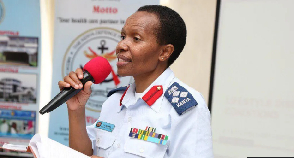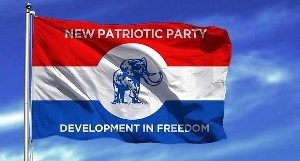- Home - News
- TWI News | TV
- Polls
- Year In Review
- News Archive
- Crime & Punishment
- Politics
- Regional
- Editorial
- Health
- Ghanaians Abroad
- Tabloid
- Africa
- Religion
- Election 2020
- Coronavirus
- News Videos | TV
- Photo Archives
- News Headlines
- Press Release
General News of Friday, 21 September 2007
Source: Public Agenda
Sea water used for bathing & Washing
As a result of the decline in water supply to most surburbs in Accra, residents of Teshie are compelled to use sea water to bath and wash their cooking utensils.
According to a report by WaterAid, a non-governmental organisation, the volume of water supply in most parts of the world including Ghana have seen a downward trend.
Over a billion people dont have access to safe drinking water and a half billion don't have somewhere safe and clean to go to toilet.
As a result a child dies every fifteen seconds from water and sanitation related diseases and people's livelihoods, education and dignity are also affected.
This unfortunate global picture does not exclude Ghana, where it is being estimated that more than nine million people do not have access to safe drinking water.
The Ghana Water Company Limited (GWCL) is responsible for urban water supply and at the moment has about 86 supply systems serving a total population of six million.
As at 2004, urban water coverage was estimated at 59 per cent and is expected to reach 85 per cent by 2015 in line with the Millennium Development Goals.
According to the Public Utilities Regulatory Commission (PURC) many urban communities face shortfalls in water supply and the situation is even more critical in the major cities.
A study by WaterAid Ghana, a non-governmental Organization in selected localities within the Greater Accra Metropolis revealed that the main source of water supply for the Metropolis was pipe borne water supply from Ghana Water Company Limited (GWCL).
The study revealed that supply of water from GWCL was inadequate to meet the increasing demand for water in urban areas on account of their obsolete equipment and limited capacity of their plants. For most households in Nima and Teshie, the taps were opened mostly in the night and only for about three or four hours.
In some instances, interruptions in water supply could last for up to six months compelling residents in the two communities to travel over long distances to fetch water.
According to the study the perennial water supply situation in the two communities and many others was as a result of damaged old pipelines, increase in demand for potable water as a result of the rapid housing and industrial development and expansion, especially in Teshie.
Besides that the secondary service providers such as water tanker services, power tillers and domestic vendors charged comparatively higher rates for water supplied.
The reports indicated that residents in Teshie living along the beach bath and wash their bowls with sea water and rinse their bodies with sachet water.
In Nima a few cups of water supply for bath and high cost of water has resulted in low water consumption levels among the poor. In some communities women and chil?dren have to spend up to 8 hours a day collecting water from far away, unprotected and possibly contaminated sources.
According to the Ministry of Water Resource, Works and Housing, an individual is required to have access to not less than 20 litres of water per day, and individuals in poor urban communities should also have access to between seven litres and 18 litres of water per day.
WaterAid says while 100% of respondents prefer water from GWCL only 45% rely on supply from this source. In Accra for example it has been estimated that only approximately 25% of residents enjoy 24-hour water supply.
Little wonder the country faces serious constraints meeting the challenge of providing adequate for all rural and urban residents. With GWCL?s unaccounted water of about 50% of total output, the volume of water that is effectively sold is less than half of the daily demand.
About 30% have an averaged 12 hours service everyday for five days a week. Another 35% have service for two days each week, while the remaining residents on the outskil1s of Accra are completely without access to piped water supplies.
It has been noted that Ghanaian cities tend to develop ahead of planning. Many new sites are therefore not connected to the water network for decades. Communities with the worst picture are those slums inhabited mainly by squatters.
Besides that they are not even legally recognized as communities by the municipal or metropolitan authorities, let alone possessing the right to water facilities. Water related diseases are therefore very prevalent in these slums.
A community with safe water facility does not only benefit from easy access to clean potable water and reduction in water borne disease but also frees up time for people usually women to have the opportunity to generate income and for children's education.
Water from unconventional sources like streams and drainage gutters are used in the absence of water from safe sources also patronage of "Sa?chet" or "pure" water becomes unusually high.
The residents of Teshie and Nima especially the poor find themselves in a vicious cycle as a result of poor access to water supply and delivery services.
The use of water from unsafe sources put residents at high risk of water related diseases.
The study revealed hat 70% of respondents n Nima and 64% in Teshie attend hospital owing to the stress they go through to access water.
According to the residents the toil involved in accessing water especially during the dry season has not only health implications on them but also deprive them of productivity especially among the self-employed.
Those who engaged in water related economic activities have no choice but to produce less or nothing at all as a result of having to invest their time searching for water.
Also in rural areas, District Assemblies need to be properly funded to fulfill their responsibilities for water services and such funding should be anchored within district-owned plans.
The World Bank in a report on meeting the challenges of accelerated and shared growth of the country indicated that while the media and many observers are focusing on the energy crisis, the country is facing a silent water crisis. This crisis also threatens the achievement of important Millennium Development Goals (MDGs).
According to the report, water has numerous economic and social activities in both private and public sectors that rely on the supply of clean water to operate.
The report stated that access to safe water in 2005 was estimated at approximately 53% for rural water, while coverage for urban water supply was estimated at 58%, a drop of some 3% from 2004.










